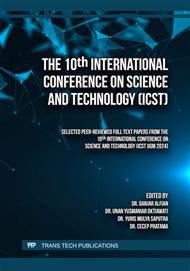[1]
Baloloy AB, Blanco AC, Candido CG, Ana RRCS , Nadaoka K. 2020. Development and application of a new mangrove vegetation index (MVI) for rapid and accurate mangrove mapping: ISPRS Journal of Photogrammetry and Remote Sensing 166 (2020) 95–117.
DOI: 10.1016/j.isprsjprs.2020.06.001
Google Scholar
[2]
Direktorat Jenderal Konservasi Sumber Daya Alam dan Ekosistem. 2021. Rencana Pengelolaan Jangka Panjang Taman Wisata Alam Teluk Youtefa Kotamadya Jayapura, Provinsi Papua. Direktorat Jenderal Konservasi Sumber Daya Alam dan Ekosistem Balai Besar Konservasi Sumberdaya Alam Papua Kementerian Lingkungan Hidup dan Kehutanan. Papua. 127 hal.
DOI: 10.31957/acr.v4i1.1762
Google Scholar
[3]
Gao X, Wen, J, Zhang C. 2019. An improved random forest algorithm for predicting employee turnover. Mathematical Problems in Engineering, 2019.
DOI: 10.1155/2019/4140707
Google Scholar
[4]
Liu K, Li X, Shi X, Wang S. Monitoring Mangrove Forest Changes Using Remote Sensing and GIS Data with Decision-Tree Learning. Wetlands 2008, 28, 336–346.
DOI: 10.1672/06-91.1
Google Scholar
[5]
Thessen A. 2016 Adoption of Machine Learning Techniques in Ecology and Earth Science. One Ecosystem 1: e8621.
DOI: 10.3897/oneeco.1.e8621
Google Scholar
[6]
Verhegghen A, Eva H, Ceccherini G, Achard F, Gond V, Gourlet-Fleury S, Cerutti PO. 2016. The potential of Sentinel satellites for burnt area mapping and monitoring in the Congo Basin forests. Remote Sens. 8, 986.
DOI: 10.3390/rs8120986
Google Scholar
[7]
Kauffman, J.B., Heider, C., Cole, T.G., Dwyer, K., Donato, D.C., 2011. Ecosystem carbon stocks of Micronesian mangrove forests. Wetlands 31, 343e352.
DOI: 10.1007/s13157-011-0148-9
Google Scholar
[8]
Kauffman, J.B., Cummings, D.L., Ward, D.E., Babbitt, R., 1995. Fire in the Brazilian Amazon: 1. Biomass, nutrient pools, and losses in slashed primary forests. Oecologia 104, 397e408.
DOI: 10.1007/bf00341336
Google Scholar
[9]
Donato, D.C., Kauffman, J.B., Kurnianto, S., Stidham, M., Murdiyarso, D., 2011. Mangroves among the most carbon-rich forests in the tropics. Nature Geoscience 4, 293e297.
DOI: 10.1038/ngeo1123
Google Scholar
[10]
Giri, C., Ochieng, E., Tieszen, L.L., Zhu, Z., Singh, A., Loveland, T., Masek, J., Duke, N., 2010. Status and distribution of mangrove forests of the world using earth observation satellite data. Global Ecology and Biogeography 20, 154e159.
DOI: 10.1111/j.1466-8238.2010.00584.x
Google Scholar
[11]
Lü, X.T., Yin, Y.X., Jepsen, M.R., Tang, J.W., 2010. Ecosystem carbon storage and partitioning in a tropical seasonal forest in Southwestern China. Forest Ecology and Management 260, 1798e1803.
DOI: 10.1016/j.foreco.2010.08.024
Google Scholar
[12]
Duke, N.C., Ball, M.C., Ellison, J.C., 1998. Factors influencing biodiversity and distributional gradients in mangroves. Global Ecology and Biogeography Letters 7, 27e47.
DOI: 10.2307/2997695
Google Scholar
[13]
Clough, B.F., Scott, K., 1989. Allometric relationships for estimating aboveground biomass in six mangrove species. Forest Ecology and Management 27, 117e127.
DOI: 10.1016/0378-1127(89)90034-0
Google Scholar
[14]
Anderson, J.R., Hardy, E.E., Roach, J.T. and Witmer, R.E. (1976) A Land Use and Land Cover Classification System for Use with Remote Sensor Data. Us Geological Survey Professional Paper 964, A Revision of the Land Use Classification System as Presented in U.S. Geological
DOI: 10.3133/pp964
Google Scholar


